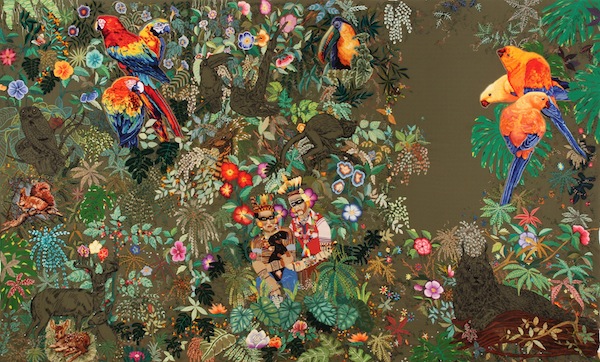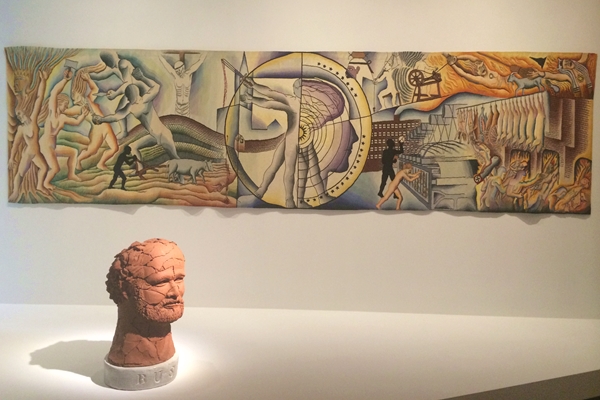Art & Exhibitions
The Museum of Arts and Design Hopes a Biennial Will Help Brighten Things Up
The New York institution has gone through a rough patch, but it has big plans.

The New York institution has gone through a rough patch, but it has big plans.

Benjamin Sutton

The Museum of Arts and Design (MAD) has had a tough century so far. In 2002 it made the semantically controversial decision to change names, from American Craft Museum—thereby earning the ire of the craft community—and in 2008 it moved to 2 Columbus Circle, radically altering the building, much to the dismay of preservation-minded observers. Its former director, Holly Hotchner, the driving force behind those transformations, left in April of 2013. Glenn Adamson took over in October, and already he’s re-energizing the institution with plans for a new biennial, an ambitious survey of an entire continent’s emerging designers, and a slew of shows honoring MAD’s history.
“Our program is really focused on makers and making, but we are also a museum about the creative economy,” Adamson, who previously worked at the Victoria and Albert Museum and wrote a highly critical article about MAD for Art in America, said this week during a luncheon at the Columbus Circle institution. “It would be great if our exhibitions were covered in the business pages just as often as they are in the arts pages.” That may come to pass, as MAD is launching a biennial exhibition, the first edition of which will highlight the work of 100 artists, artisans, fabricators, and other assorted “makers” based in New York City. That exhibition is will open on July 1 and run through October 12.
“It is as much an event as an exhibition, and it has the excitement of a summer festival,” Adamson boasted. The curator is MAD’s director of public programs, Jake Yuzna—collaborating with a selection jury chaired by Murray Moss and including Joe Ahearn, Lisa Dent, and Robert Wilson, who looked over hundreds of nominated artists—and has designs on virtually every available corner of the museum.

Misha Kahn, Pig Bench (2012).
Photo: Misha Kahn.
“I’m using the galleries, the lobby, the stairwells, the elevators,” Yuzna said. “I was even hoping to install something in Glenn’s office.” The range of objects lined up for “NYC Makers: The MAD Biennial” will certainly lend itself well to this type of unconventional installation. In addition to works by well-known artists like Ei Arakawa and Laurie Anderson, chosen makers include the set design team at the Metropolitan Opera, surrealist furniture designer Misha Kahn, and a local candy company.
As if starting a biennial weren’t a sufficiently grandiose project to mark the beginning of Adamson’s tenure, MAD’s chief curator Lowery Stokes Sims is preparing what may be the institution’s largest exhibition to date, focused on Latin American designers. That exhibition, “New Territories: Laboratories for Design, Craft, and Art in Latin America,” is slated to open in the fall and, in contrast to 2010’s exhibition “The Global Africa Project” (which Sims co-curated), this continental survey will highlight emerging artists and designers based in specific cities. “Emerging” in what way, exactly?
“I think even those who are very knowledgeable about Latin American design won’t recognize 90 percent of the names in the exhibition,” Adamson said. “You’ve probably heard of the Campana Brothers; this is everybody else.”
In addition to these enormous survey shows of local talent and emerging Latin American figures, MAD under Adamson will stay true to its roots. The museum’s upcoming programming includes a retrospective devoted to the esteemed designer Wendell Castle (running June 23–October 11, 2015) that will draw heavily on the institution’s permanent collection. Even further down the line, the promising exhibition “Many Hands: Artists and Their Fabricators” will highlight the often downplayed relationship between art stars and the artists realizing their most technically complex projects.

Installation view of “Re: Collection.”
Photo: Benjamin Sutton.
In the more immediate future, the museum will pay tribute to its founder, Aileen Osborne Webb, with the exhibition “What Would Mrs. Webb Do?,” opening in September 2014. And, in a similar spirit, the newly opened exhibition “Re: Collection” tracks the career of MAD’s recently retired chief curator David McFadden, showcasing works the institution acquired during his 16-year tenure, including an incredible tapestry from Judy Chicago and Audrey Cowan’s Holocaust Project series (1993) and a cabinet of Quaker dishes by James Turrell, Nicholas Mosse, and Bill Burke. MAD’s prospects are looking up thanks to this mix of expansive surveys and inwardly focused shows.